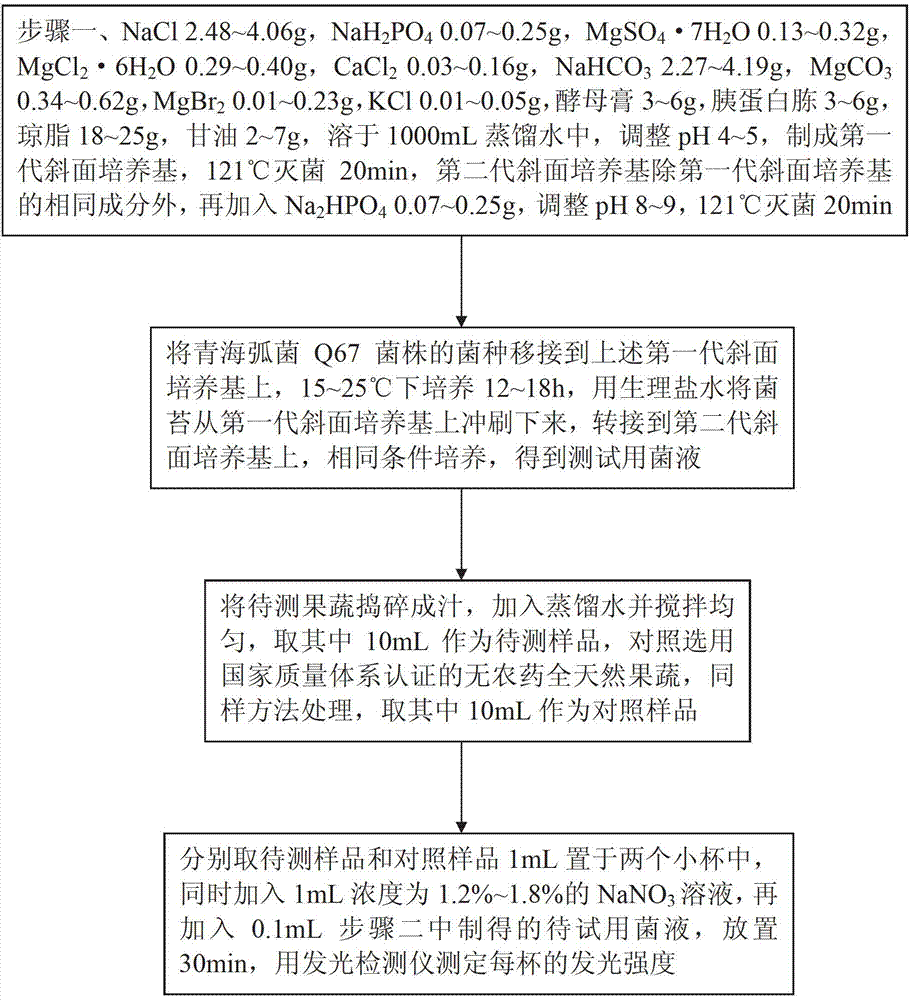Method for detecting residual pesticidal toxicity in fruits and vegetables
A pesticide residue and detection method technology, which is applied in the direction of chemical reaction of materials for analysis, chemiluminescence/bioluminescence, etc., can solve the problems of limited luminescence time and the detection of the toxicity of pesticide residues in fruits and vegetables, so as to avoid missed detection, The effect of prolonging the stable light emission time
- Summary
- Abstract
- Description
- Claims
- Application Information
AI Technical Summary
Problems solved by technology
Method used
Image
Examples
Embodiment 1
[0030] NaCl 3.67g, NaH 2 PO 4 0.18g, MgSO 4 ·7H 2 O 0.18g, MgCl 2 ·6H 2 O 0.39g, CaCl 2 0.07g, NaHCO 3 3.41g, MgCO 3 0.53g, MgBr 20.07g, KCl 0.03g, yeast extract 5g, tryptone 5g, agar 20g, glycerol 3g, dissolve in 1000mL distilled water, adjust the pH to 4.5, make the first-generation slant medium, sterilize at 121℃ for 20min, the second-generation In addition to the same components of the first-generation slant medium, the slant medium was added with Na 2 HPO 4 0.18g, adjust the pH to 8.5, and sterilize at 121°C for 20min; transplant the bacteria of Vibrio Qinghai Q67 strain to the above-mentioned first-generation slant medium, cultivate it at 20°C for 16h, and use 0.85% normal saline to cover the bacterial lawn Wash off from the slant medium, then transfer to the second-generation slant medium, and cultivate in the same way to obtain the bacterial liquid for testing. Mash 10g of common cucumber purchased from farmers’ market into juice, add 40mL of distilled ...
Embodiment 2
[0032] NaCl 3.15g, NaH 2 PO 4 0.24g, MgSO 4 ·7H 2 O 0.29g, MgCl 2 ·6H 2 O 0.31g, CaCl 2 0.14g, NaHCO 3 2.72g, MgCO 3 0.47g, MgBr 2 0.19g, KCl 0.02g, yeast extract 4g, tryptone 4g, agar 23g, glycerol 5g, dissolve in 1000mL distilled water, adjust the pH to 4, make the first generation slant medium, sterilize at 121℃ for 20min, the second generation In addition to the same components of the first-generation slant medium, the slant medium was added with Na 2 HPO 4 0.24g, adjust the pH to 8, and sterilize at 121°C for 20min; transplant the bacteria of Vibrio Qinghai Q67 strain to the above-mentioned first-generation slant medium, cultivate it at 23°C for 15h, and use 0.85% normal saline to cover the bacterial lawn Wash off from the slant medium, then transfer to the second-generation slant medium, and cultivate in the same way to obtain the bacterial liquid for testing. Mashed 10g of ordinary apples purchased from farmers’ markets into juice, added 40mL of distill...
PUM
 Login to View More
Login to View More Abstract
Description
Claims
Application Information
 Login to View More
Login to View More - R&D
- Intellectual Property
- Life Sciences
- Materials
- Tech Scout
- Unparalleled Data Quality
- Higher Quality Content
- 60% Fewer Hallucinations
Browse by: Latest US Patents, China's latest patents, Technical Efficacy Thesaurus, Application Domain, Technology Topic, Popular Technical Reports.
© 2025 PatSnap. All rights reserved.Legal|Privacy policy|Modern Slavery Act Transparency Statement|Sitemap|About US| Contact US: help@patsnap.com

